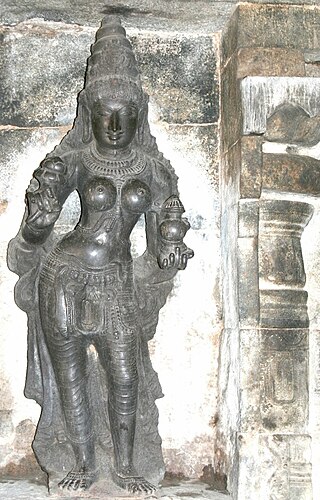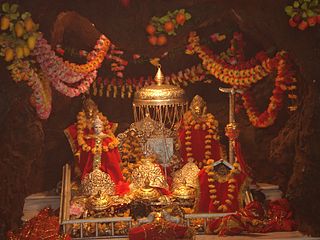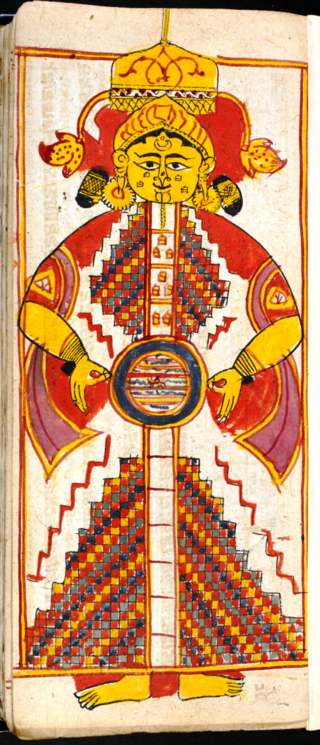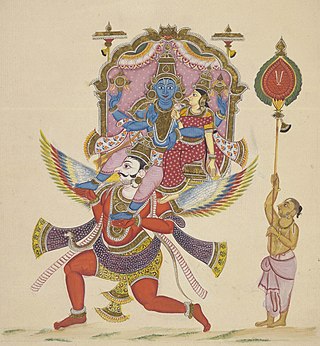Related Research Articles
Dyaus, or Dyaus-pitr, is the Ṛgvedic sky deity. His consort is Prthvi, the earth goddess, and together they are the archetypal parents in the Rigveda.

Amrita, Amrit or Amata in Pali, is a Sanskrit word that means "immortality". It is a central concept within Indian religions and is often referred to in ancient Indian texts as an elixir. Its first occurrence is in the Rigveda, where it is considered one of several synonyms for soma, the drink of the devas. Amrita plays a significant role in the Samudra Manthana, and is the cause of the conflict between devas and asuras competing for amrita to obtain immortality.
Indian poetry and Indian literature in general, has a long history dating back to Vedic times. They were written in various Indian languages such as Vedic Sanskrit, Classical Sanskrit, Ancient Meitei, Modern Meitei, Telugu, Tamil, Odia, Maithili, Kannada, Bengali, Assamese, Urdu, and Hindi. Poetry in foreign languages such as English also has a strong influence on Indian poetry. The poetry reflects diverse spiritual traditions within India. In particular, many Indian poets have been inspired by mystical experiences. Poetry is the oldest form of literature and has a rich written and oral tradition.

Vaishno Devi is a manifestation of the Hindu mother goddess Lakshmi sometimes in some beliefs Vaishno Devi is considered a manifestation of goddess Mahalakshmi. Vaishno Devi is worshipped as a combined avatar of the goddesses Mahakali, Mahalakshmi, and Mahasaraswati. Additionally, she is seen as the potency of Hari or Vishnu.
The pitrs are the spirits of departed ancestors in Hinduism. Following an individual's death, the performance of the antyesti is regarded to allow the deceased to enter Pitrloka, the abode of one's ancestors. The non-performance of these rituals is believed to result in the fate of wandering the earth as a restless preta.
South Asian literature refers to the literature that is composed by authors in the Indian subcontinent and its diaspora. It has an extensive history with some of the earliest known pieces of literature. South Asia has many different languages that have been spoken due to its size and how long people have been inhabiting it. This has caused the region to be the most linguistically diverse region in the planet, and as well as having four language families, hundreds of languages and thousands of dialects. Many modern pieces of South Asian literature are written in English for a global audience. Many of the ancient texts of the subcontinent have been lost due to the inability to preserve verbally transmitted literature. South Asia has many significant authors that shaped the postcolonial period and response to the British establishment in the subcontinent. Modern South Asian literature has a deep focus on independence from Britain, mainly expressed in prose, this literature commonly discusses the partition of India and how different South Asian nations, religions, and cultures interact with each other. Countries to which South Asian literature's writers are linked include India, Pakistan, Bangladesh, Sri Lanka and Nepal. Works from Bhutan, Myanmar, Tibet, and the Maldives are sometimes also included.

Dola Purnima, also popularly known as Dolo Jatra, Doul Utsav or Deul, is a Hindu swing festival celebrated during the Holi festival of Braj region, Rajasthan, Gujarat, Odisha, Assam, Tripura and Bengal region. This festival is dedicated to the divine couple of Radha and Krishna. It is usually celebrated on the full moon night or fifteenth day of the Falgun month mainly by Gopal community.

Loka is a concept in Hinduism and other Indian religions, that may be translated as a planet, the universe, a plane, or a realm of existence. In some philosophies, it may also be interpreted as a mental state that one can experience. A primary concept in several Indian religions is the idea that different lokas are home to various divine beings, and one takes birth in such realms based on their karma.

Lakshmi Narayana or Lakshmi Narayan is the dual representation of the Hindu deities Vishnu, also known as Narayana, and his consort, Lakshmi, traditionally featured in their abode, Vaikuntha. The goddess of prosperity and beauty, Lakshmi, is depicted as standing next to Vishnu, who holds the Panchajanya, Kaumodaki, Padma, and the Sudarshana Chakra. Another depiction of Lakshmi-Narayana portrays Lakshmi in the service of Narayana, who reclines on the cosmic serpent Shesha, floating in the Kshira Sagara, the Ocean of Milk.

Pralaya is a concept in Hindu eschatology. Generally referring to four different phenomena, it is most commonly used to indicate the event of the dissolution of the entire universe that follows a kalpa called the Brahmapralaya.

Mukhwas is a colorful Indian Ayurvedic after-meal snack or digestive aid widely used as a breath freshener, especially after meals. As per Agamas, Mukhwaas forms one of the components of sixteen upcharas (offerings) to a deity in a Puja, the Hindu mode of worship or prayer. can be made of various seeds and nuts, often fennel, anise, coconut, coriander, and sesame. They are sweet in flavor and highly aromatic due to added sugar and the addition of various essential oils, including peppermint oil. The seeds can be savory or sweet—coated in sugar and brightly colored.
Harita is a king in Hindu literature. He is described to be the son of Yauvanāśva, and the grandson of King Ambarisha of the Suryavamsha dynasty.
Danda is a region frequently mentioned in Hindu mythology, and is prominently featured in various narratives, such as Dandaka, which refers to both a kingdom and forest of the same name. Danda was a colonial state of Lanka during the reign of Ravana, with his governor Khara ruling the province. The region served as a stronghold for all the Rakshasa tribes living in the Dandaka Forest

The Hindu marriage is the most important of all the samskaras, the rites of passage described in the Dharmashastra texts.

Peda or Pera is an Indian sweet that originated in the city of Mathura, Uttar Pradesh, India. Traditionally prepared as thick, semi-soft round balls, its main ingredients are khoa, sugar and traditional flavourings including cardamom seeds. It is brown in colour. Variant spellings and names for the dessert include pedha, penda and pera.

Manda roti is a traditional Indian roti which finds mention in religious Sanskrit literature like purāṇas to ayurvedic & pākakalā texts like Nighantus & Bhojanakutūhala. This roti is extremely thin and limp, and served folded like a handkerchief. Manda roti is usually made with a combination of whole wheat atta flour and white wheaten maida flour and cooked on the convex side of a kadahi. It is also known as veechu roti in Tamil or Mandige in other parts of South India.
Tanvi is a feminine given name which means "slender-bodied maiden" in Sanskrit. It is an epithet of the Hindu goddess Parvati. Notable people with the name include:

Agnipravesham, also called Agnipariksha is the mythical practice of self-immolation described in Hindu literature. It is primarily associated with the ordeal of Sita in the Ramayana, and is regarded to be a custom inspired by Vedic tradition.

The Bhagavadajjukam is a Sanskrit farce composed in the 7th century CE, usually attributed to Bodhayana. However, inscriptional and scholarly evidence indicate that the play was written by the Pallava king Mahendravarman I, who also wrote a prominent farce known as the Mattavilasa Prahasana. It is one of the two earliest surviving examples of a satirical play in Sanskrit literature. Featuring witty exchanges, an episode about the transmigration of souls and a discussion on Hindu dharma, the comical play was intended to mock the doctrines of Buddhism, whose rise at the time presented a challenge to the dominance of Hinduism in India.
References
- ↑ "आचार्य अभिनवगुप्त द्वारा रचित तंत्रलोक: संस्कृत एवम् हिन्दी अनुवाद (पाँच खंडों में) Tantraloka of Abhinavagupta (In Five Volumes) | Exotic India Art". www.exoticindiaart.com. Retrieved 2023-05-31.
- ↑ Mark, Joshua J. "Arthashastra". World History Encyclopedia. Retrieved 2023-05-31.
- ↑ "Ramayana | Summary, Characters, & Facts | Britannica". www.britannica.com. 2023-05-08. Retrieved 2023-05-31.
- ↑ www.wisdomlib.org (2014-12-14). "Yoga Vasistha [English], Volume 1-4". www.wisdomlib.org. Retrieved 2023-05-31.